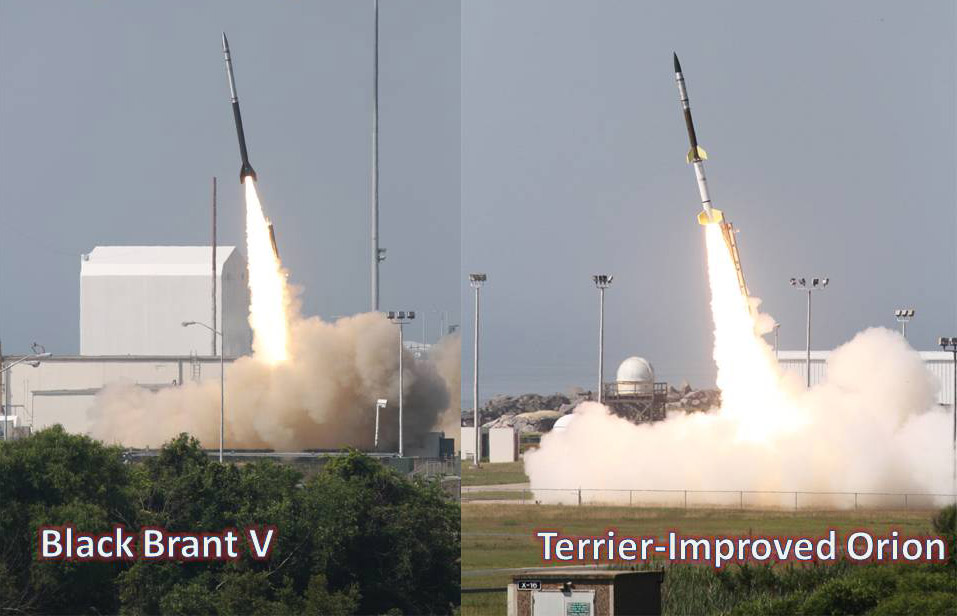NASA's Fourth of July Fireworks: 2 Rockets Launching Today

Editor's Note: NASA successfully launch its Fourth of July rocket fireworks on July 4. Read the full story and see photos: Rockets' Red Glare! NASA Marks Fourth of July with Double Launch
NASA is hoping to celebrate the Fourth of July with some fireworks if its own today with a double rocket launch from Virginia's Eastern Shore.
After a series of weather delays, scientists at NASA's Wallops Flight Facility on Wallops Island, Va., will try to launch two small sounding rockets just 15 seconds apart in an experiment to study electrical currents in Earth's atmosphere. The launches could blast off between 9:30 a.m. EDT and 11:30 a.m. EDT (1330 and 1530 GMT), weather permitting.
You can watch NASA's double rocket launch live on SPACE.com here beginning at 9:30 a.m. EDT, courtesy of Wallops officials.
Today's planned Fourth of July rocket launches are part of NASA's Dynamo project, a mission to study the global electrical current in the Earth's ionosphere between 30 and 600 miles (48 and 965 kilometers) above the planet's surface.
This current, also known as the dynamo, is used every day by people on Earth, NASA officials said. Radio waves are regular bounced of the ionosphere to relay signals around the world. Signals from communications and navigation satellites pass through the ionosphere, but disruptions in the atmospheric layer can distort those signals.
The experiment could also help scientists determine if dynamos exist on other planets, too.
Get the Space.com Newsletter
Breaking space news, the latest updates on rocket launches, skywatching events and more!
"The manner in which neutral and ionized gases interact is a fundamental part of nature," the mission's principle investigator Robert Pfaff of NASA's Goddard Space Flight Center in Greenbelt, Md., said in a statement. "There could very well be a dynamo on other planets. Jupiter, Saturn, Uranus and Neptune are all huge planets with huge atmospheres and huge magnetic fields. They could be setting up dynamo currents galore."
The Dynamo mission is a joint project by NASA and the Japan Aerospace Exploration Agency to launch two rockets with different instruments to monitor the electrical eddies of the ionosphere. NASA initially attempted to launch the mission on June 24 but cloudy weather prevented the flight. Since then, a series of weather issues due to clouds and high winds have delayed the launches.

The larger of the two sounding rockets is a Black Brant V, a 35-foot-long (10 meters) booster that will carry a 600-pound (272 kilograms) payload to measure the neutral and charged particles it encounters in the ionosphere. The smaller booster is a 33-foot (10.6 m) Terrier-Orion sounding rocket and is built to release a long trail of lithium gas in the ionosphere. According to a NASA description, this gas will allow scientists to track wind speed variations in the Earth's atmosphere, a key measurement since the winds are thought to drive the electric dynamo process.
NASA has launched such lithium gas tracers into the upper atmosphere with sounding rockets before, but those flights have typically launched at night, when the gas can glow in the night sky and be visible by observers on the ground. [Photos: NASA Paints Night Sky Red with Rocket Launch]
For today's daytime launch, Japanese researchers and scientists with Clemson University in South Carolina invented a new technology that uses the lithium trails as a tracer that can be tracked in daylight by cameras equipped with special filters. A NASA aircraft will also monitor the Dynamo experiment from the air to collect more observations above the haze and cloud layers, NASA officials said.
Both sounding rockets can reach suborbital space 100 miles (160 km) above Earth, but are not powerful enough to enter orbit. Each flight will last about five minutes from liftoff to re-entry.
While NASA will webcast the attempted launches of the Dynamo mission, the liftoffs should also be visible to local observers at the Wallops Flight Facility and its surrounding area. The facility's Visitor Center will be open at 8 a.m. EDT for members of the public. You can find directions to the NASA Visitor Center at Wallops here.
Editor's note: If you live near NASA's Wallops Flight Facility and snap a photo of the Dynamo rocket launches that you would like to share for a possible story or image gallery, please send images and comments to managing editor Tariq Malik at spacephotos@space.com.
Email Tariq Malik at tmalik@space.com or follow him @tariqjmalik and Google+. Follow us @Spacedotcom, Facebook and Google+. Original article on SPACE.com.
Join our Space Forums to keep talking space on the latest missions, night sky and more! And if you have a news tip, correction or comment, let us know at: community@space.com.

Tariq is the Editor-in-Chief of Space.com and joined the team in 2001, first as an intern and staff writer, and later as an editor. He covers human spaceflight, exploration and space science, as well as skywatching and entertainment. He became Space.com's Managing Editor in 2009 and Editor-in-Chief in 2019. Before joining Space.com, Tariq was a staff reporter for The Los Angeles Times covering education and city beats in La Habra, Fullerton and Huntington Beach. In October 2022, Tariq received the Harry Kolcum Award for excellence in space reporting from the National Space Club Florida Committee. He is also an Eagle Scout (yes, he has the Space Exploration merit badge) and went to Space Camp four times as a kid and a fifth time as an adult. He has journalism degrees from the University of Southern California and New York University. You can find Tariq at Space.com and as the co-host to the This Week In Space podcast with space historian Rod Pyle on the TWiT network. To see his latest project, you can follow Tariq on Twitter @tariqjmalik.
